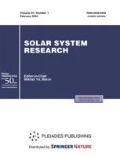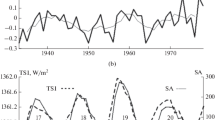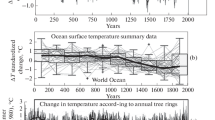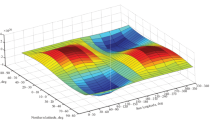Abstract
By its physical nature, the interannual variability of the solar radiation arriving at the Earth is a duplex with varying ratios of the amplitudes of the components depending on the time resolution. The analysis shows that the amplitude of the long-term variability of the radiation intensity is approximately 95% determined by the variations related to changes in the solar activity. At an annual resolution, the component determined by the solar activity is predominant in amplitude (approximately 80%). At a monthly resolution, the leading component of the duplex is the variation caused by the celestial-mechanical processes (approximately 55%). Thus, the interannual variations determined by the celestial-mechanical processes dominate in the interannual variability of incoming solar radiation within seasonal changes. The results point toward the necessity for a differentiated approach to the use of the values of the interannual solar radiation variability of different physical nature in the climatic models since their weight ratios depend on the time resolution.








Similar content being viewed by others
REFERENCES
Borisenkov, E.P., Tsvetkov, A.V., and Eddy, J.A., Combined effects of Earth orbit perturbations and solar activity on terrestrial insolation. Part 1: Sample days and annual mean values, J. Atmos. Sci., 1985, vol. 42, no. 9, pp. 933–940.
Climate Change 2013: The Physical Science Basis. Contribution of Working Group I to the Fifth Assessment Report of the Intergovernmental Panel on Climate Change, Ch. 8: Anthropogenic and Natural Radiative Forcing, Cambridge: Cambridge Univ. Press, 2013, pp. 659–740. https://doi.org/10.1017/CBO9781107415324.018
Fedorov, V.M., Interannual variability of the solar constant, Sol. Syst. Res., 2012, vol. 46, no. 2, pp. 170–176. https://doi.org/10.1134/S0038094612020049
Fedorov, V.M., Interannual variations in the duration of the tropical year, Dokl. Earth Sci., 2013, vol. 451, no. 1, pp. 750–753. https://doi.org/10.1134/S1028334X13070015
Fedorov, V.M., Spatial and temporal variations in solar climate of the earth in the present epoch, Izv., Atmos. Ocean. Phys., 2015, vol. 51, no. 8, pp. 779–791.
Fedorov, V.M., Theoretical calculation of the interannual variability of the Earth`s insolation with daily resolution, Sol. Syst. Res., 2016, vol. 50, no. 3, pp. 220–224. https://doi.org/10.1134/S0038094616030011
Foukal, P., Fröhlich, C., Spruit, H., and Wigley, T.M.L., Variations in solar luminosity and their effect on the Earth’s climate, Nature, 2006, vol. 443, pp. 161–166. https://doi.org/10.1038/nature05072
Fröhlich, C. and Lean, J., The Sun’s total irradiance: cycles, trends and climate change uncertainties since 1976, Geophys. Res. Lett., 1998, vol. 25, pp. 4377–4380.
Fröhlich, C., Observations of irradiance variability, Space Sci. Rev., 2000, vol. 94, pp. 15–24.
Fröhlich, C., Total solar irradiance observations, Surv. Geophys., 2012, vol. 33, pp. 453–473. https://doi.org/10.1007/s10712-011-9168-5
JPL Solar System dynamics, Jet Propulsion Laboratory California Institute of Technology, NASA. http:// ssd.jpl.nasa.gov.
Kopp, G. and Lean, J.L., A new, lover value of total solar irradiance: evidence and climate significance, Geophys. Res. Lett., 2011, vol. 38, p. L01706. https://doi.org/10.1029/2010GL045777
Kopp, G., Fehlmann, A., Finsterle, W., Harber, D., Heuerman, K., and Willson, R., Total solar irradiance data record accuracy and consistency improvements, Metrologia, 2012, vol. 49, no. 2. https://doi.org/10.1088/0026-1394/49/2/S29
Lean, J., Beer, J., and Bradley, R., Reconstruction of solar irradiance since 1610: Implications for climate change, Geophys. Res. Lett., 1995, vol. 22, pp. 3195–3198.
Lean, J., Rottman, G., Harder, J., and Kopp, G., SORCE contributions to new understanding of global change and solar variability, Sol. Phys., 2005, vol. 230, pp. 27–53.
Author information
Authors and Affiliations
Corresponding author
Additional information
Translated by M. Chubarova
Rights and permissions
About this article
Cite this article
Fedorov, V.M. Analysis of the Components of a Different Physical Nature in the Interannual Variability of the Total Solar Irradiance Flux. Sol Syst Res 53, 376–382 (2019). https://doi.org/10.1134/S0038094619040026
Received:
Revised:
Accepted:
Published:
Issue Date:
DOI: https://doi.org/10.1134/S0038094619040026




